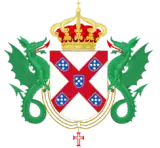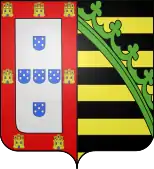Pedro V of Portugal
Peter V (Portuguese: Pedro V Portuguese pronunciation: [ˈpeðɾu]; 16 September 1837 – 11 November 1861), nicknamed "the Hopeful" (Portuguese: o Esperançoso), was King of Portugal from 1853 to 1861.
| Peter V | |||||
|---|---|---|---|---|---|
 | |||||
| King of Portugal | |||||
| Reign | 15 November 1853 – 11 November 1861 | ||||
| Acclamation | 16 September 1855 | ||||
| Predecessor | Maria II | ||||
| Successor | Luís I | ||||
| Regent | Fernando II (1853–1855) | ||||
| Prime Ministers | |||||
| Born | 16 September 1837 Necessidades Palace, Lisbon | ||||
| Died | 11 November 1861 (aged 24) Necessidades Palace, Lisbon | ||||
| Burial | |||||
| Spouse | Princess Stephanie of Hohenzollern-Sigmaringen | ||||
| |||||
| House | Braganza[1] | ||||
| Father | Prince Ferdinand of Saxe-Coburg and Gotha-Koháry | ||||
| Mother | Queen Maria II of Portugal | ||||
| Religion | Roman Catholicism | ||||
| Signature | |||||
Early life and reign
As the eldest son of Queen Maria II and King Ferdinand II, Peter was a member of the House of Braganza.[1] As heir apparent to the throne he was styled Prince Royal (Portuguese: Príncipe Real), and was also the 19th Duke of Braganza (Duque de Bragança).
Peter was a conscientious and hard-working monarch who, under the guidance of his father, sought radical modernisation of the Portuguese state and infrastructure. Under his reign, roads, telegraphs, and railways were constructed and improvements in public health advanced. His popularity increased when, during the cholera outbreak of 1853–1856, he visited hospitals handing out gifts and comforting the sick.
Pedro V, along with his brothers Fernando and João and other royal family members, succumbed to typhoid fever or cholera in 1861.
.png.webp)
Marriage
Peter married Princess Stephanie of Hohenzollern-Sigmaringen, eldest daughter of Karl Anton, Prince of Hohenzollern-Sigmaringen, and Princess Josephine of Baden, by proxy in Berlin on 29 April 1858 and then in person in Lisbon on 18 May 1858. It was a happy marriage until Queen Stephanie died a year later from diphtheria. As Peter and Stephanie's marriage was childless, the Portuguese throne passed to his brother Luís.
Titles, styles and honours
Titles and styles
| Royal styles of King Peter V of Portugal | |
|---|---|
.png.webp) | |
| Reference style | His Most Faithful Majesty |
| Spoken style | Your Most Faithful Majesty |
- 16 September 1837 – 15 November 1853: His Royal Highness The Prince Royal of Portugal, Duke of Braganza
- 15 November 1853 – 11 November 1861: His Most Faithful Majesty The King of Portugal and the Algarves
Pedro V's official styling as King of Portugal: By the Grace of God and by the Constitution of the Monarchy, Peter V, King of Portugal and the Algarves, of either side of the sea in Africa, Lord of Guinea and of Conquest, Navigation, and Commerce of Ethiopia, South Africa, Arabia, Persia and India, etc.[2]
As heir apparent to the Portuguese crown, Peter held the following titles:[3]
- Duke of Braganza (23rd)
- Duke of Barcelos (18th)
- Duke of Guimarães (20th)
- Marquis of Vila Viçosa (22nd)
- Count of Ourém (24th)
- Count of Barcelos (24th)
- Count of Faria and Neiva (24th)
- Count of Arraiolos (26th)
- Count of Guimarães (21st)
Honours
- Domestic[4]
- He was Grand Master of the following orders:
- Foreign[4]
 Austrian Empire: Grand Cross of St. Stephen, 1854[5]
Austrian Empire: Grand Cross of St. Stephen, 1854[5].svg.png.webp) Belgium: Grand Cordon of the Order of Leopold, 9 July 1854[6]
Belgium: Grand Cordon of the Order of Leopold, 9 July 1854[6].svg.png.webp) Empire of Brazil: Grand Cross of the Southern Cross, 1855
Empire of Brazil: Grand Cross of the Southern Cross, 1855.svg.png.webp)
.svg.png.webp)
.svg.png.webp) Ernestine duchies: Grand Cross of the Saxe-Ernestine House Order
Ernestine duchies: Grand Cross of the Saxe-Ernestine House Order.svg.png.webp) French Empire: Grand Cross of the Legion of Honour
French Empire: Grand Cross of the Legion of Honour Hohenzollern: Cross of Honour of the Princely House Order of Hohenzollern, 1st Class
Hohenzollern: Cross of Honour of the Princely House Order of Hohenzollern, 1st Class Netherlands: Grand Cross of the Netherlands Lion
Netherlands: Grand Cross of the Netherlands Lion.svg.png.webp) Kingdom of Prussia: Knight of the Black Eagle
Kingdom of Prussia: Knight of the Black Eagle Russian Empire:[7]
Russian Empire:[7]
- Knight of St. Andrew, 13 March 1856
- Knight of St. Alexander Nevsky, 13 March 1856
- Knight of the White Eagle, 13 March 1856
- Knight of St. Anna, 1st Class, 13 March 1856
.svg.png.webp) Kingdom of Sardinia:
Kingdom of Sardinia:
- Knight of the Annunciation, 15 July 1855[8]
- Grand Cross of Saints Maurice and Lazarus, 1855
.svg.png.webp) Saxe-Weimar-Eisenach: Grand Cross of the White Falcon, 1 August 1854[9]
Saxe-Weimar-Eisenach: Grand Cross of the White Falcon, 1 August 1854[9].svg.png.webp) Kingdom of Saxony: Knight of the Rue Crown, 1854[10]
Kingdom of Saxony: Knight of the Rue Crown, 1854[10].svg.png.webp) Spain: Knight of the Golden Fleece, 13 November 1846[11]
Spain: Knight of the Golden Fleece, 13 November 1846[11].svg.png.webp) Two Sicilies: Grand Cross of St. Ferdinand and Merit
Two Sicilies: Grand Cross of St. Ferdinand and Merit United Kingdom: Knight of the Garter, 24 June 1858[12]
United Kingdom: Knight of the Garter, 24 June 1858[12]
Ancestry
See also
| Wikimedia Commons has media related to Pedro V of Portugal. |
References
- "While remaining patrilineal dynasts of the duchy of Saxe-Coburg and Gotha according to pp. 88, 116 of the 1944 Almanach de Gotha, Title 1, Chapter 1, Article 5 of the 1838 Portuguese constitution declared, with respect to Ferdinand II of Portugal's issue by his first wife, that 'the Most Serene House of Braganza is the reigning house of Portugal and continues through the Person of the Lady Queen Maria II'. Thus their mutual descendants constitute the Coburg line of the House of Braganza"
- Pinto 1883, pp. XV–XVI.
- Castelo Branco e Torres 1838, pp. XXIV–XXV, XXXIV.
- Pinto 1883, p. XVI.
- "A Szent István Rend tagjai" Archived 22 December 2010 at the Wayback Machine
- Ferdinand Veldekens (1858). Le livre d'or de l'ordre de Léopold et de la croix de fer. lelong. p. 203.
- Bragança, Jose Vicente de; Estrela, Paulo Jorge (2017). "Troca de Decorações entre os Reis de Portugal e os Imperadores da Rússia" [Exchange of Decorations between the Kings of Portugal and the Emperors of Russia]. Pro Phalaris (in Portuguese). 16: 6–7. Retrieved 19 March 2020.
- Cibrario, Luigi (1869). Notizia storica del nobilissimo ordine supremo della santissima Annunziata. Sunto degli statuti, catalogo dei cavalieri (in Italian). Eredi Botta. p. 115. Retrieved 4 March 2019.
- Staatshandbuch für das Großherzogtum Sachsen / Sachsen-Weimar-Eisenach (1864), "Großherzogliche Hausorden" p. 13
- Staatshandbuch für den Freistaat Sachsen (1857) (in German), "Königliche Ritter-Orden", p. 4
- "Caballeros Existentes en la Insignie Orden del Toison de Oro", Calendario manual y guía de forasteros en Madrid (in Spanish): 172, 1860, retrieved 26 April 2020
- Shaw, Wm. A. (1906) The Knights of England, I, London, p. 60
- Pinto 1883, pp. XV–XLVII.
Further reading
- Castelo Branco e Torres, João Carlos Feo Cardoso de (1838). Resenha das familias titulares do Reino de Portugal: acompanhada das notícias biographicas de alguns individuos das mesmas famílias (in Portuguese). Lisbon: Imprensa Nacional.
- Pinto, Albano da Silveira (1883). Resenha das familias titulares e grandes de Portugal (in Portuguese). I. Lisbon: Francisco Arthur da Silva.
Pedro V of Portugal Cadet branch of the House of Aviz Born: 16 September 1837 Died: 11 November 1861 | ||
| Regnal titles | ||
|---|---|---|
| Preceded by Maria II |
King of Portugal 1853–1861 |
Succeeded by Luís I |

